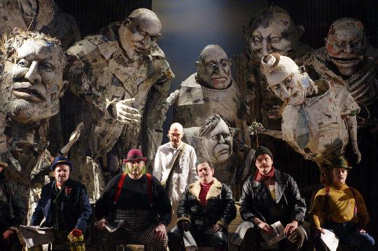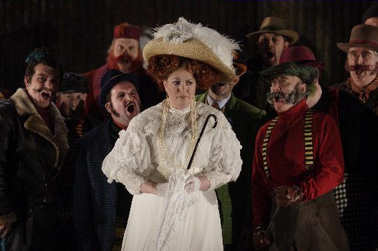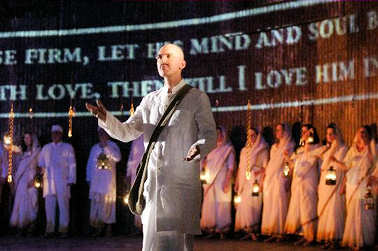|
|
|

Editorial
Board
London Editor:
(London UK)
Melanie
Eskenazi
Regional Editor:
(UK regions and Worldwide)
Bill
Kenny
Webmaster:
Bill
Kenny
Music Web Webmaster:
Len
Mullenger



|
MusicWeb is a
subscription-free site
Clicking Google adverts on our pages helps us keep it that way
Seen
and Heard Opera Review
Philip
Glass , Satyagraha:
Soloists,
Orchestra and Chorus of the ENO, Johannes
Rebus (conductor) , Skills Ensemble
, English National Opera, The Coliseum,
London 6.04.2007 (AO)
Cast:
Alan
Oke (Gandhi)
Elena Xanthoudakis (Miss Schlesen,Gandhi’s
secretary)
Janis Kelly (Mrs Naidoo)
Anne Marie Gibbons (Mrs Gandhi)
Ashley Holland, James Gower, Jane
Rigby (co-workers and friends)
Robert Poulton (Prince Arjuna)
Production:
Phelim McDermott (director)
Julian
Crouch (designer)

After
experiencing Koyaanisqatsi
twice, I thought I was inoculated
against Philip Glass. However,
a friend, who knows the opera – and
very few do – insisted that Satyagraha
was different, and good.
Since his tastes are more conservative
than mine, it was a recommendation
to act on. He was absolutely right
: Satyagraha is amazing!
The opera deals with M K Gandhi’s
experiences in South Africa in 1906,
when India was part of the British
Empire. At the time, Gandhi
was a lawyer in a three piece suit,
dutifully embracing the image of Edwardian
idealism. He mixed with other
liberals, who believed that colonialism
could be changed by earnest discussion
and writing letters to the newspapers. But Gandhi realised that words weren’t
enough for real change.
Gradually
he developed the concept of Satyagraha,
a raft of ideas which were a complete
antithesis to the materialism and
power politics of Empire. Instead
of challenging Empire on its own terms,
Satyagraha presented a far
more fundamental alternative. Ultimately,
by rejecting the colonial power game,
Gandhi was able to win Indian Independence.
Gandhi's inspiration came from Ancient
Sanskrit texts. Appropriately in this
production, a primeval battle scene
is enacted by gigantic puppets, evoking
the juggernauts of Indian tradition.
They tower over the stage, and are
extremely elaborate and detailed.
They are meant to “shock and awe” . But puppets they are, however
formidable. As the puppeteers
step down from their stilts, the giants
disintegrate, and we see that they
are hollow constructs made by ordinary
men.The image is extremely
powerful, and important, because it
captures the soul of Gandhi’s struggle.
Moreover, the puppets are made of
newsprint. The printed word
was important, and Gandhi’s journal
Indian Opinion was widely
read. Throughout this production,
images of newsprint appear – banners
of paper, as if fresh off a printing
press, papier maché creations,
images of newspaper headlines superimposed
on the backdrop. The images
appear relentlessly but ultimately,
words alone are meaningless.
“Action”, says Gandhi, is a form of
“spiritual exercise”. The Satyagraha
movement revolved around simple living,
focussed on idealistic communes where
humble tasks were shared by all, regardless
of race or status. In colonial society
that was revolutionary and profoundly
subversive. No wonder the authorities
reacted violently, with savage racial
laws. Later in the opera, as the movement
gains momentum through strikes and
civil action, festoons of newsprint
are torn to shreds, the debris swept
away by bands of actors with small
brooms – just like peasants in India.
Even more striking is the scene where
the stage is criss-crossed with what
seems to be shining ribbons of light,
carefully woven into a maze-like pattern.
It’s visually stunning, but the lines
are then revealed as sticky tape,
transparent but impossible to unravel.

Just as Gandhi symbolically exchanges
his suit for a loincloth in order
to progress, in the final Act, a man
is clothed in a sharp suit as if the
knowledge gained by Satyagraha were
a kind of spiritual armour.
The man climbs a ladder to a window
open onto the skies:he is Martin Luther
King, empowered by inner wisdom.
Satyagraha
is a spiritual experience because
of its subject matter, but that alone
doesn’t “make” an opera. Much
has been made of the fact that the
text is in Sanskrit, but I believe
that is a deliberate part of Glass’s
method. Of course few can understand
the language, but that’s the whole
point. When you read a Buddhist sutra,
it’s not “what” you are reading that
counts but what you learn from absorbing
the spirit of the texts. Words
are just beacons in a wider mental
journey. It’s not nearly as
important to understand the exact
words as they are sung, but to understand
their overall portent. This
is completely different to what we’re
used to, just as non-violence was
a complete reversal of authoritarian
power. Words here become an
extension of the very concept behind
the subject. Key phrases are
beamed onto the backdrop, and remain
there for fairly long periods so you
can focus and refocus : quite the
opposite of fleeting subtitles.
In the Stuttgart production, the phrases
were written by actors as they were
sung, and so were not nearly as effective
as in this production.
Even Glass’s minimalist technique
seems to work in this particular context.
The very repetitiveness of it means that
a listener doesn’t need to focus on
every note. Instead, the imagination
can float “over” the notes, so to
speak, the better to concentrate on
meaning. It’s very similar to
Buddhist chanting where single sounds
are repeated over and over until they
blend into the subconscious, freeing
the mind from temporal concerns.
It’s not a technique unique to Buddhism,
of course, but it works. On
closer examination though, Glass’s
music is surprisingly natural, rather
like the normal rhythm of breathing.
Accordingly, the vocal parts, while
demanding, are not forced. Indeed,
some sections are quite beautifully
lyrical, such as the long aria (if
you can call it that) for Gandhi in
the Final Act. I don’t like
minimalism for its own sake, and find
a lot of Cage, Reich and Glass soporific.
In the case of Satyagraha,
however, minimalism makes sense because
it’s used in support of what is essentially
minimalist, oblique subject matter.
In the first act, the conflict between
two opposing worldviews is expressed
though contrasting string and woodwind
passages.
In the final
act, cadences rise ever higher, “climbing
a ladder” aspirationally, just as
the Martin Luther King character does
on stage. It’s also tricky music
to perform, as missing a bar, or fluffing
a note would disrupt the organic flow.
Wisely, the ENO brought in Johannes
Rebus, a conductor attuned to these
subtleties. He brought out unusually
fine playing from the orchestra, who
seemed much more focussed than has
sometimes been the case.

Alan
Oke was a wonderful Gandhi, supported
by a good cast and chorus. Top
honours, though, to the director Phelim
McDermott, who has clearly understood
the multiple levels of meaning.
This was truly inspired staging, which
extended the libretto “beyond words”,
and was thus much more faithful to
the spirit of the music and text than
a literal staging. Improbable, the independent theatre company which
McDermott is involved in, and which
created this production, is a troupe
with imagination, and specialist technical
skills, such as circus and illusion
work. Opera is theatre, and these
skills can come in handy, but most
opera houses just can’t afford to
maintain full-time specialists. Whoever
decided to hire Improbable for this
production for ENO deserves an accolade,
too, for it’s a stroke of administrative
and creative brilliance.
Once word gets round
that Glass is not to be feared, this
production will be appreciated for
what it is. I sincerely hope
so, because its complicated philosophic
content may well be more difficult
for audiences to cope with than Glass’s
music per se. But it’s an excellent
production and deserves to be a hit.
Anne
Ozorio
Pictures
© Catherine Ashmore
Back
to the Top
Back to the Index Page
|
Seen and Heard, one of the longest established live
music review web sites on the Internet, publishes original reviews
of recitals, concerts and opera performances from the UK and internationally.
We update often, and sometimes daily, to bring you fast reviews,
each of which offers a breadth of knowledge and attention to performance
detail that is sometimes difficult for readers to find elsewhere.
Seen and Heard
publishes interviews with musicians, musicologists and directors
which feature both established artists and lesser known performers.
We also feature articles on the classical music industry and we
use other arts media to connect between music and culture in its
widest terms.
Seen and Heard
aims to present the best in new criticism from writers with a radical
viewpoint and welcomes contributions from all nations. If you would
like to find out more email Regional
Editor Bill Kenny. |
|
| |
|
Contributors: Marc
Bridle, Martin Anderson, Patrick Burnson, Frank Cadenhead, Colin
Clarke, Paul Conway, Geoff Diggines, Sarah Dunlop, Evan Dickerson
Melanie Eskenazi (London Editor) Robert J Farr, Abigail Frymann,
Göran Forsling, Simon Hewitt-Jones, Bruce Hodges,Tim Hodgkinson,
Martin Hoyle, Bernard Jacobson, Tristan Jakob-Hoff, Ben Killeen,
Bill Kenny (Regional Editor), Ian Lace, John Leeman, Sue Loder,Jean
Martin, Neil McGowan, Bettina Mara, Robin Mitchell-Boyask, Simon
Morgan, Aline Nassif, Anne Ozorio, Ian Pace, John Phillips,
Jim Pritchard, John Quinn, Peter Quantrill, Alex Russell, Paul
Serotsky, Harvey Steiman, Christopher Thomas, Raymond Walker, John Warnaby,
Hans-Theodor Wolhfahrt, Peter Grahame Woolf (Founder & Emeritus
Editor)
|
Site design: Bill Kenny
2004 |

